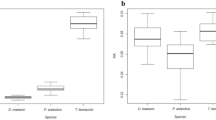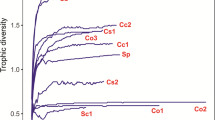Abstract
Although many notothenioid fishes are primarily carnivorous, some species consistently feed on macroalgae and are therefore omnivorous. Among fish, the degree of herbivory is usually reflected in the morphology of the gastrointestinal system especially intestine length. We examined a large number of juvenile and adult specimens of nine sympatric notothenioid species collected sequentially over eight summer seasons at Potter Cove, South Shetland Islands. We provide relative intestine lengths (RIL), distinct proportions of algae and animal prey in the diets (W%), and numbers of pyloric caeca for all species. The sister species Notothenia coriiceps (NOC) and N. rossii (NOR) evidenced significantly different intestinal growth over ontogeny and ate distinctly different proportions of algae and animal prey. We establish a ranking of the degree of herbivory for the fish species in the local ecosystem, and this was found to be related to their distinct feeding types and strategies. There is a correspondence between intestine length/RILs and degree of herbivory in six of the nine species analysed but no clear association between the number of pyloric caeca and degree of omnivory or carnivory. Compared to other teleosts, our results, and those in the literature, indicate modest divergence in notothenioids that include a phylogenetic decrease in the number of pyloric caeca, from 6 to 7 in most nototheniids to 2–3 in channichthyids, and a 1.8-fold difference in average relative intestine lengths which are most frequently 50–70% of body length and never exceed body length. This is consistent with the unspecialized gastrointestinal morphology that reflects the dietary and ecological plasticity of many notothenioids, exemplified by the high degree of omnivory in species such as NOC and NOR.




Similar content being viewed by others
References
Amsler CD, Iken K, McClintock JB, Amsler MO, Peters KJ, Hubbard JM, Furrow FB, Baker BJ (2005) Comprehensive evaluation of the palatability and chemical defenses of subtidal macroalgae from the Antarctic Peninsula. Mar Ecol Prog Ser 294:141–159. https://doi.org/10.3354/meps294141
Atkinson A, Siegel V, Pakhomov E, Rothery P, Loeb V, Ross RM, Quetin LB, Schmidt K, Fretwell P, Murphy EJ, Tarling GA, Fleming AH (2008) Oceanic circumpolar habitats of Antarctic krill. Mar Ecol Prog Series 362:1–23. https://doi.org/10.3354/meps07498
Bakke AM, Glover C, Krogdahl A (2011) Feeding, digestion and absorption of nutrients. In: Grosell M, Farrell AP, Brauner CJ (eds) Fish physiology, vol 30. Academic Press, London, pp 57–110
Barrera-Oro E (2002) The role of fish in the Antarctic marine food web: differences between inshore and offshore waters in the southern Scotia Arc and west Antarctic Peninsula. Antarct Sci 14:293–309
Barrera-Oro ER, Casaux RJ (1990) Feeding selectivity in Notothenia neglecta, Nybelin, from Potter Cove, South Shetland Islands, Antarctica. Antarct Sci 2:207–213
Barrera-Oro ER, Piacentino GLM (2007) Feeding habits of juvenile Trematomus newnesi (Pisces, Nototheniidae) at Potter Cove, South Shetland Islands, Antarctica. Polar Biol 30(6):789–796
Barrera-Oro ER, Winter D (2008) Age composition and feeding ecology of early juvenile Notothenia rossii (Pisces, Nototheniidae) at Potter Cove, South Shetland Islands, Antarctica. Antarct Sci 20:339–341
Barrera-Oro E, Moreira E, Seefeldt M, Valli Francione M, Quartino ML (2019) The importance of macroalgae and associated amphipods in the selective benthic feeding of sister rockcod species Notothenia rossii and N. coriiceps (Nototheniidae) in West Antarctica. Polar Biol 42:317–334
Barrington EJW (1957) The alimentary canal and digestion. In: Brown ME (ed) The physiology of fishes, vol 1. Academic Press, New York, pp 109–161
Benavides AG, Cancino JM, Ojeda FP (1994) Ontogenetic changes in gut dimensions and macroalgal digestibility in the marine herbivorous fish, Aplodactylus punctatus. Funct Ecol 8:46–51
Bone Q, Moore RH (2008) Biology of fishes, 3rd edn. Taylor & Francis, New York
Casaux R (1998) The contrasting diet of Harpagifer antarcticus (Notothenioidei, Harpagiferidae) at two localities of the South Shetland Islands, Antarctica. Polar Biol 19(4):283–285
Casaux R, Barrera-Oro E (2013) Dietary overlap in inshore notothenioid fish from the Danco Coast, western Antarctic Peninsula. Polar Res 32(21319):1–8. https://doi.org/10.3402/polar.v32i0.21319
Casaux RJ, Mazzotta AS, Barrera-Oro ER (1990) Seasonal aspects of the biology and diet of nearshore nototheniid fish at Potter Cove, South Shetland Islands, Antarctica. Polar Biol 11:63–72
Casaux R, Barrera-Oro E, Baroni A, Ramón A (2003) Ecology of inshore notothenioid fish from the Danco Coast, Antarctic Peninsula. Polar Biol 26:157–165
Clements KD, Raubenheimer D (2006) Feeding and nutrition. In: Evans DH, Clairborne JB (eds) The physiology of fishes, 3rd edn. CTC Press, Boca Raton, pp 47–82
Clements KD, Raubenheimer D, Choat JH (2009) Nutritional ecology of marine herbivorous fishes: ten years on. Funct Ecol 23:79–92. https://doi.org/10.1111/j.1365-2435.2008.01524.x
Daniels RA (1982) Feeding ecology of some fishes of the Antarctic Peninsula. Fish Bull US 80:575–588
Daniels RA, Lipps JH (1982) Distribution and ecology of fishes of the Antarctic Peninsula. J Biogeogr 9:1–19
Eastman JT (2005) The nature of the diversity of Antarctic fishes. Polar Biol 28:93–107
Eastman JT, DeVries AL (1997) Morphology of the digestive system of Antarctic nototheniid fishes. Polar Biol 17:1–13
Eastman JT, Barrera-Oro E, Moreira E (2011) Adaptive radiation at a low taxonomic level: divergence in buoyancy of the ecologically similar Antarctic fish Notothenia coriiceps and N. rossii. Mar Ecol Prog Ser 438:195–206
Elliott JP, Bellwood DR (2003) Alimentary tract morphology and diet in three coral reef fish families. J Fish Biol 63:1598–1609. https://doi.org/10.1046/j.1095-8649.2003.00272.x
Foster BA, Montgomery JC (1993) Planktivory in benthic nototheniid fish in McMurdo Sound, Antarctica. Environ Biol Fish 36:313–318
Gon O, Heemstra PC (eds) (1990) Fishes of the Southern Ocean. JLB Smith Institute of Ichthyology, Grahams Town
Gröhsler T (1994) Feeding habits as indicators of ecological niches: investigations of Antarctic fish conducted near Elephant Island in late autumn/winter 1986. Arch Fish Mar Res 42:17–34
Harmelin-Vivien ML (2002) Energetics and fish diversity on coral reefs. In: Sale PF (ed) Coral reef fishes: dynamics and diversity in a complex ecosystem. Academic Press, San Diego, pp 265–274
Horn MH (1989) Biology of marine herbivorous fishes. Oceanogr Mar Biol 27:167–272
Hossain A, Dutta HM (1988) Embryology of intestinal caeca in thebluegill (Lepomis macrochirus). Can J Zool 66:998–1003
Iken K, Barrera-Oro ER, Quartino ML, Casaux RJ, Brey T (1997) Grazing by the Antarctic fish Notothenia coriiceps: evidence for selective feeding on macroalgae. Antarct Sci 9:386–391
Jenkins RE, Burkhead NM (1993) Freshwater fishes of Virginia. American Fisheries Society, Bethesda
Juares MA (2013) Biología reproductiva y ecología trófica de dos especies simpátricas del género Pygoscelis en las Islas Shetland del Sur, Antártida. Tesis Doctoral. Facultad de Ciencias Naturales y Museo, Universidad Nacional de La Plata, La Plata, Buenos Aires, Argentina. https://hdl.handle.net/10915/27166
Kiest KA (1993) A relationship of diet to prey abundance and the foraging behavior of Trematomus bernacchii. Polar Biol 13:291–296
Kock KH (2005) Antarctic icefishes (Channichthyidae): a unique family of fishes. A review. Part I Polar Biol 28:862–895
Kock KH, Kellermann A (1991) Reproduction in Antarctic notothenioid fish. Antarct Sci 3:125–150
Kock KH (1992) Antarctic fish and fisheries. Cambridge University Press, Cambridge
Kock KH, Barrera-Oro E, Belchier M, Collins MA, Duhamel G, Hanchet S, Pshenichnov L (2012) The role of fish as predators of krill (Euphausia superba) and other pelagic resources in the Southern Ocean. CCAMLR Sci 19:115–169
Korovina VM (1986) Anatomical-histological perculiarities of the intestine of Patagonotothen ramsayi (Nototheniidae). J Ichthyol 26:48–54
Korovina VM, Prirodina VP (1986) Anatomical-histological features of the intestine of the sculpin spinecheek, Cottoperca gobio, (Bovichthyidae, Notothenioidei). J Ichthyol 26:130–136
Korovina VM, Neyelov AV, Bondarenko EP (1986) Structure of intestine of Chaenocephalus aceratus (Lönnberg) (Channichthyidae, Notothenioidei). USSR Acad Sci Proc Zool Inst Leningrad 162:110–114 [In Russian]
Korovina VM, Neyelov AV, Bondarenko YP (1991a) The anatomy and histology of the intestine of the Patagonian toothfish (Dissostichus eleginoides Smitt). J Ichthyol 31:34–40
Korovina VM, Neyelov AV, Bondarenko YP (1991b) Intestinal anatomy and histology of the marbled notothenia, Notothenia rossii marmorata. J Ichthyol 31:79–90
Korovina VM, Voronina EP, Neelov AV (2004) Comparative characteristics of the alimentary tract of toothfishes of the genus Dissostichus (Nototheniidae). J Ichthyol 44:239–244
Marina TI, Salinas V, Cordone G, Campana G, Moreira E, Deregibus D, Torre L, Sahade R, Tatian M, Barrera-Oro E, De Troch M, Doyle S, Quartino ML, Saravia L, Momo FR (2018) The food web of Potter Cove (Antarctica): complexity, structure and function. Estuar Coast Shelf Sci. https://doi.org/10.1016/j.ecss.2017.10.015
McKenna JE (1991) Trophic relationships within the Antarctic demersal fish community of South Georgia Island. Fish Bull US 89:643–654
Montgomery WL, Gerking SD (1980) Marine macroalgae as food for fishes: an evaluation of potential food quality. Environ Biol Fish 5:143–153
Moreira E (2015) Ictiofauna Antártica: Ecología de estadíos juveniles de especies del Suborden Notothenioidei de Caleta Potter, Isla 25 de Mayo. Tesis doctoral. FCNyM, Universidad Nacional de la Plata. https://sedici.unlp.edu.ar/handle/10915/50216
Moreira E, Juáres M, Barrera-Oro E (2014) Dietary overlap among early juvenile stages in an Antarctic notothenioid fish assemblage at Potter Cove, South Shetland Islands. Polar Biol 37:1507–1515. https://doi.org/10.1007/s00300-014-1545-3
Moreno CA (1980) Observation on food and reproduction in Trematomus bernacchii (Pisces: Nototheniidae) from the Palmer Archipelago, Antarctica. Copeia 1:171–173
Near TJ, MacGuigan DJ, Parker E, Struthers CD, Jones CD, Dornburg A (2018) Phylogenetic analysis of Antarctic notothenioids illuminates the utility of RADseq for resolving Cenozoic adaptive radiations. Mol Phylogen Evol 129:268–279. https://doi.org/10.1016/j.ympev.2018.09.001
Nybelin O (1947) Antarctic fishes. Sci Results Nor Antarct Exped 1927–1928(26):1–76
Ojeda FP (1986) Morphological characterization of the alimentary tract of Antarctic fishes and its relation to feeding habits. Polar Biol 5:125–128
R Development Core Team (2009) R: A language and environment for statistical computing. R Foundation for Statistical Computing, Vienna
Siegel V, Watkins JL (2016) Distribution, biomass and demography of Antarctic Krill Euphausia superba. Biology and ecology of Antarctic Krill. Springer, Berlin
Sokal R, Rohlf F (1981) Biometry, 2nd edn. W.H. Freeman, San Francisco, CA
Targett TE (1981) Trophic ecology and structure of coastal Antarctic fish communities. Mar Ecol Prog Ser 4:243–263
Targett TE, Radtke RL (1984) Growth and feeding ecology studies on coastal Antarctic fishes. Antarct J US 19:147–149
Voronina EP (1999) Some specific features of the structure of the digestive tract of Gvozdarus svetovidovi (Pleuragramminae, Nototheniidae). J Ichthyol 39:127–129
Voronina EP, Balushkin AV (1998) Morphological features of the digestive tract in four genera of notothenioid fishes (Nototheniidae). J Ichthyol 38:781–788
Voronina EP, Neelov AV (2001) Structural traits of alimentary tract of fishes of the family Channichthyidae (Notothenioidei). J Ichthyol 41:778–788
Wilson JM, Castro LFC (2011) Morphological diversity of the gastrointestinal tract in fishes. In: Grosell M, Farrell AP, Brauner CJ (eds) Fish physiology, vol 30. Academic Press, London, pp 1–55
Zamzow JP, Aumack CF, Amsler CD, McClintock JB, Amsler MO, Baker BJ (2011) Gut contents and stable isotope analyses of the Antarctic fish, Notothenia coriiceps (Richardson), from two macroalgal communities. Antarct Sci 23:107–116. https://doi.org/10.1017/s095410201000091x
Acknowledgements
We thank Carlos Bellisio for his help in field activities and laboratory tasks and to Mina Gordon for her help in the manuscript preparation. We thank three referees, Drs. M. Vacchi, E. Riginella and R.R. Eakin, for their constructive comments. This study was supported by grants from Dirección Nacional del Antártico, Instituto Antártico Argentino (PICTA 0100), PIP 2017–2019 GI 11220170100219CO, Resolution 2018-8-APN-DIR#CONICET and PICT 2018-03310, Resolution 401/19.
Author information
Authors and Affiliations
Corresponding author
Ethics declarations
Conflict of interest
The authors declare that they have no conflicts of interest.
Ethical approval
All applicable international, national and/or institutional guidelines for the care and use of animals were followed.
Additional information
Publisher's Note
Springer Nature remains neutral with regard to jurisdictional claims in published maps and institutional affiliations.
Rights and permissions
About this article
Cite this article
Moreira, E., Novillo, M., Eastman, J.T. et al. Degree of herbivory and intestinal morphology in nine notothenioid fishes from the western Antarctic Peninsula. Polar Biol 43, 535–544 (2020). https://doi.org/10.1007/s00300-020-02655-w
Received:
Revised:
Accepted:
Published:
Issue Date:
DOI: https://doi.org/10.1007/s00300-020-02655-w




